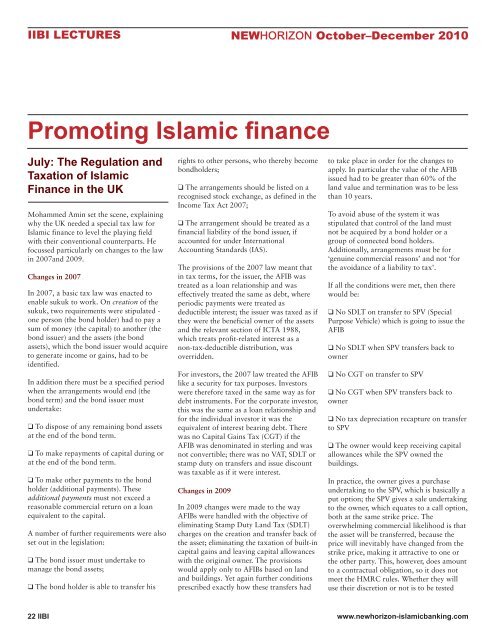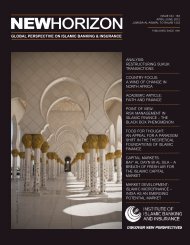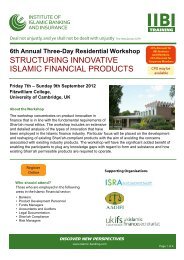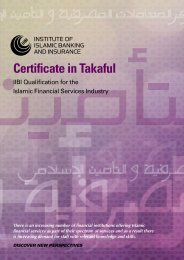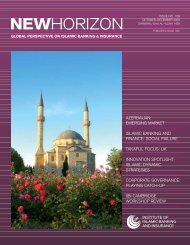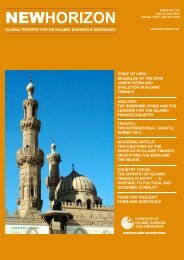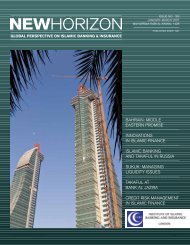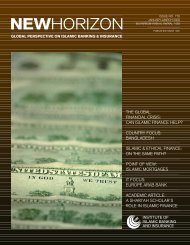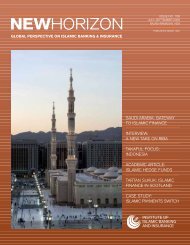NEWHORIZON
NEWHORIZON - Institute of Islamic Banking and Insurance
NEWHORIZON - Institute of Islamic Banking and Insurance
- No tags were found...
Create successful ePaper yourself
Turn your PDF publications into a flip-book with our unique Google optimized e-Paper software.
IIBI LECTURES<br />
<strong>NEWHORIZON</strong> October–December 2010<br />
Promoting Islamic finance<br />
July: The Regulation and<br />
Taxation of Islamic<br />
Finance in the UK<br />
Mohammed Amin set the scene, explaining<br />
why the UK needed a special tax law for<br />
Islamic finance to level the playing field<br />
with their conventional counterparts. He<br />
focussed particularly on changes to the law<br />
in 2007and 2009.<br />
Changes in 2007<br />
In 2007, a basic tax law was enacted to<br />
enable sukuk to work. On creation of the<br />
sukuk, two requirements were stipulated -<br />
one person (the bond holder) had to pay a<br />
sum of money (the capital) to another (the<br />
bond issuer) and the assets (the bond<br />
assets), which the bond issuer would acquire<br />
to generate income or gains, had to be<br />
identified.<br />
In addition there must be a specified period<br />
when the arrangements would end (the<br />
bond term) and the bond issuer must<br />
undertake:<br />
❑ To dispose of any remaining bond assets<br />
at the end of the bond term.<br />
❑ To make repayments of capital during or<br />
at the end of the bond term.<br />
❑ To make other payments to the bond<br />
holder (additional payments). These<br />
additional payments must not exceed a<br />
reasonable commercial return on a loan<br />
equivalent to the capital.<br />
A number of further requirements were also<br />
set out in the legislation:<br />
❑ The bond issuer must undertake to<br />
manage the bond assets;<br />
❑ The bond holder is able to transfer his<br />
rights to other persons, who thereby become<br />
bondholders;<br />
❑ The arrangements should be listed on a<br />
recognised stock exchange, as defined in the<br />
Income Tax Act 2007;<br />
❑ The arrangement should be treated as a<br />
financial liability of the bond issuer, if<br />
accounted for under International<br />
Accounting Standards (IAS).<br />
The provisions of the 2007 law meant that<br />
in tax terms, for the issuer, the AFIB was<br />
treated as a loan relationship and was<br />
effectively treated the same as debt, where<br />
periodic payments were treated as<br />
deductible interest; the issuer was taxed as if<br />
they were the beneficial owner of the assets<br />
and the relevant section of ICTA 1988,<br />
which treats profit-related interest as a<br />
non-tax-deductible distribution, was<br />
overridden.<br />
For investors, the 2007 law treated the AFIB<br />
like a security for tax purposes. Investors<br />
were therefore taxed in the same way as for<br />
debt instruments. For the corporate investor,<br />
this was the same as a loan relationship and<br />
for the individual investor it was the<br />
equivalent of interest bearing debt. There<br />
was no Capital Gains Tax (CGT) if the<br />
AFIB was denominated in sterling and was<br />
not convertible; there was no VAT, SDLT or<br />
stamp duty on transfers and issue discount<br />
was taxable as if it were interest.<br />
Changes in 2009<br />
In 2009 changes were made to the way<br />
AFIBs were handled with the objective of<br />
eliminating Stamp Duty Land Tax (SDLT)<br />
charges on the creation and transfer back of<br />
the asset; eliminating the taxation of built-in<br />
capital gains and leaving capital allowances<br />
with the original owner. The provisions<br />
would apply only to AFIBs based on land<br />
and buildings. Yet again further conditions<br />
prescribed exactly how these transfers had<br />
to take place in order for the changes to<br />
apply. In particular the value of the AFIB<br />
issued had to be greater than 60% of the<br />
land value and termination was to be less<br />
than 10 years.<br />
To avoid abuse of the system it was<br />
stipulated that control of the land must<br />
not be acquired by a bond holder or a<br />
group of connected bond holders.<br />
Additionally, arrangements must be for<br />
‘genuine commercial reasons’ and not ‘for<br />
the avoidance of a liability to tax’.<br />
If all the conditions were met, then there<br />
would be:<br />
❑ No SDLT on transfer to SPV (Special<br />
Purpose Vehicle) which is going to issue the<br />
AFIB<br />
❑ No SDLT when SPV transfers back to<br />
owner<br />
❑ No CGT on transfer to SPV<br />
❑ No CGT when SPV transfers back to<br />
owner<br />
❑ No tax depreciation recapture on transfer<br />
to SPV<br />
❑ The owner would keep receiving capital<br />
allowances while the SPV owned the<br />
buildings.<br />
In practice, the owner gives a purchase<br />
undertaking to the SPV, which is basically a<br />
put option; the SPV gives a sale undertaking<br />
to the owner, which equates to a call option,<br />
both at the same strike price. The<br />
overwhelming commercial likelihood is that<br />
the asset will be transferred, because the<br />
price will inevitably have changed from the<br />
strike price, making it attractive to one or<br />
the other party. This, however, does amount<br />
to a contractual obligation, so it does not<br />
meet the HMRC rules. Whether they will<br />
use their discretion or not is to be tested<br />
22 IIBI<br />
www.newhorizon-islamicbanking.com


